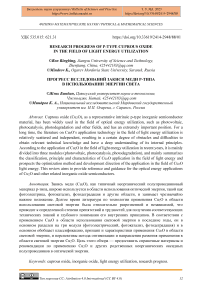Research progress of p-type cuprous oxide in the field of light energy utilization
Автор: Ren Bingbing, Mindrov Konstntin
Журнал: Бюллетень науки и практики @bulletennauki
Рубрика: Физико-математические науки
Статья в выпуске: 3 т.9, 2023 года.
Бесплатный доступ
Cuprous oxide (Cu2O), as a representative intrinsic p-type inorganic semiconductor material, has been widely used in the field of optical energy utilization, such as photovoltaic, photocatalysis, photodegradation and other fields, and has an extremely important position. For a long time, the literature on Cu2O’s application technology in the field of light energy utilization is relatively scattered and independent, resulting in a certain degree of obstacles and difficulties to obtain relevant technical knowledge and have a deep understanding of its internal principles. According to the application of Cu2O in the field of light energy utilization in recent years, it is mainly divided into three modules (photovoltaic, photocatalysis, photodegradation), and mainly summarizes the classification, principle and characteristics of Cu2O application in the field of light energy and prospects the optimization method and development direction of the application in the field of Cu2O light energy. This review aims to provide reference and guidance for the optical energy applications of Cu2O and other related inorganic oxide semiconductors.
Cuprous oxide, inorganic oxide, light energy utilization, research progress
Короткий адрес: https://sciup.org/14127160
IDR: 14127160 | УДК: 535.015: | DOI: 10.33619/2414-2948/88/01
Текст обзорной статьи Research progress of p-type cuprous oxide in the field of light energy utilization
Бюллетень науки и практики / Bulletin of Science and Practice
УДК 535.015: 621.31
Cu 2 O is a promising p-type semiconductor material, with a direct bandgap structure of 2.17eV, high electrical conductivity, high carrier mobility, non-toxic and rich content and other properties that make Cu 2 O is widely used in various industries [1-6].
In the photovoltaic field, Cu 2 O is mainly used as the hole transmission material and light absorption material in solar cells [7-12]. Due to the direct band-gap structure of Cu 2 O, Cu 2 O can effectively absorb in the visible light range of the solar spectrum. At the same time [13], compared with the side effects of dilution, transfer, transformation, oxidation and ozone treatment measures of traditional pollution treatment measures, nano copper oxide in photocatalysts that degrade organic pollutants has been attracting attention to in the field of photocatalysis industry due to its strong oxidation ability [14-18], high catalytic activity and good stability. Photodegradation refers to the phenomenon of pollutant decomposition caused by the action of light. These include photochemical degradation, polymer photodegradation, photodegradable plastics, and photodegradable photosensitive polymers. However, Cu 2 O is mainly used in [19-23] photochemical degradation and polymer photodegradation.
As a traditional inorganic oxide semiconductor material proposed and applied as early as 1926 [24], although the previous literature has been introduced and summarized to a certain extent, but the content is relatively scattered and independent, and the explanation of the process and mechanism is relatively simple. This paper will systematically classify, summarize and summarize the various kinds of Cu 2 O in the field of light energy utilization, and advance the various technical schemes. Line analysis and summary, aiming to play a enlightening and synergistic role in the application of Cu 2 O.
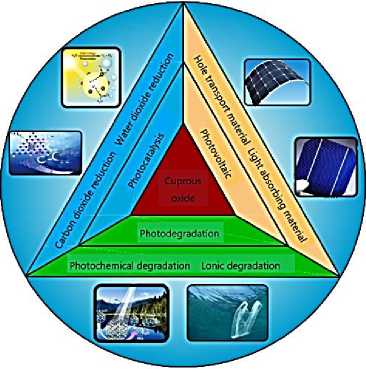
Figure 1. Application neighborhood of cuprous oxide
Photovoltaic Field
Solar photovoltaic effect, hereinafter referred to as photovoltaic (PV), refers to the phenomenon of potential difference between uneven semiconductor or semiconductor and metal combination during light. Photovoltaic technology has many advantages, such as no mechanical operating parts; except sunlight; working in both direct and oblique sunlight. Among them, nano-copper oxide has the advantages of rich raw materials, high theoretical conversion efficiency and direct energy band structure, which has become a relatively potential solar cell material in recent years [25-27].
Cave Transmission Material
Cu 2 O, as a hole transmission material, can improve the open circuit voltage, short circuit current and photocurrent of solar cells, thus improving the efficiency and stability of solar cells by [8, 28]. In
Бюллетень науки и практики / Bulletin of Science and Practice Т. 9. №3. 2023
2015, Hossain [29] used wxAMPS and SCAPS software to calculate key features of CH3NH3PbI3-based solar cells. The results showed that solar cells containing Cu 2 O as the HTM outperformed all other organic or inorganic HTM devices tested to date. The obtained power conversion efficiency exceeded 24%. Moreover, the use of Cu 2 O is expected to provide moisture protection for perovskite, thus improving the performance of the device. These results suggest that, by replacing the expensive and water-sensitive spiro-OMETAD with Cu 2 O, it promises to further improve the performance of perovskite cells and reduce their cost. In the same year, Yu [1] prepared perovskite layers with 11.0% PCE under AM1.5G nano-Cu 2 O film (5 nm) HTM illumination.
In addition, the ultra-thin properties of Cu 2 O films help reduce the material consumption and manufacturing costs of large-scale production of perovskite solar cells. The thickness and performance of the Cu 2 O layer must be precisely adjusted to achieve optimal solar cell performance. I n 2016, Nejand [30] introduced inorganic sandwich perovskite solar cells, with a PCE value of 8.93%.The use of Cu 2 O as the HTM on the pinhole and needle-free perovskite layers yields high values of power conversion efficiency, especially when the pinhole-free perovskite layers are used.According to photoluminescence studies, Cu 2 O shows better hole pumping capacity (holeextraction) com- pared to Spiro-OMeTAD, proving that it is a promising candidate for alternatives to expensive organic HTMs in perovskite solar cells.
Moreover, in 2017, Guo [31] et al. synthesized Cu 2 O films through reactive magnetron sputtering at room temperature (Figure 2a). The maximum power conversion efficiency of the OSCs based on the classic PTB7: PC71BM active layer is 8.61% (Figure 2b), 15% higher than the OSCs (solar cell) in the standard PEDOT: PSSHTM layer. Devices based on Cu oxide HTM exhibit better energy level alignment, reduced series resistance, and therefore improved charge extraction capability. The results show that high mobility, low series resistance and better band energy alignment are related to improving the pumping capacity of the device, improving the performance of the shortcircuit current density and filling factor in the Cu oxide solar cells.
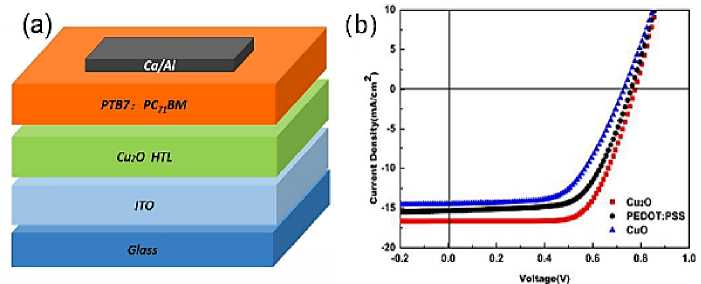
Figure 2. (a) Schematic diagram of planar body heterojunction solar cell, (b) OsCS power conversion efficiency diagram based on PTB7:PC71BM system [31]
Later, in 2019, Elseman [32] provided a p-type hole transport layer (HTL) for a regularly structured nano-Cu 2 O (p-i-p) perovskite solar cell. This work is the first to use this treated Cu 2 O nanocubic solution as a top layer in perovskite solar cells. He prepared (100) crystal surfaces of 60 to 80 n m without surfactant and template and found that Cu 2 O nanocrystalline were not easy to reunite. The synergistic effect of different Cu 2 O nanocubic concentrations on the photovoltaic performance was investigated, and the optimized Cu 2 O-based PSC was 17.23% higher than the device PCE where P3HT is HTL. The Cu 2 O nanocubes showed more stability at room temperature compared to P3HT.The results show that the Cu 2 O nanocubes can be used to prepare highly efficient and stable PSCs, and they are a very promising hole transport layer.
Бюллетень науки и практики / Bulletin of Science and Practice Т. 9. №3. 2023
The Absorption Layer
Cu 2 O began to be studied as a photoelectric conversion material in the 1970s. At present, many heterojunction solar cells combined with n-type semiconductors such as ZnO, CdO, and ITO have been reported, among which the theoretical conversion efficiency of Cu 2 O/ZnO solar cells can reach 20% [33]. The conversion efficiency of Cu 2 O/ZnO heterojunction solar cells is significantly improved by doping and interface control, but the current experimental data only show a conversion efficiency of about 2% [34]. Meanwhile, different thicknesses also affect the optical response properties of Cu 2 O films. In 2012, Gershon [35] proposed a new approach to overcome the limitations of low long-wavelength absorption and short charge transport length in electrodeposited bilayer ZnO/Cu 2 O solar cells. Here, the Gershon reduces the thickness of the Cu 2 O to the transport length of about a few charge carriers, and covers a thin film of a semiconductor polymer between the Cu 2 O and the top electrode. Experiments show that the ZnO/Cu 2 O photoabsorption layer of 2.7 m thickness shows the best light absorption at the Cu 2 O thickness of 0.85 m. We show that achieving the ratio of optical absorption to film thickness is a promising way to overcome the charge transport difference and low-wavelength absorption in copper oxide electrodeposited films.
In 2015, Soundaram [34] successfully prepared the ZnO/Cu 2 O/ITO heterostructures deposited by SILAR. The study showed that the SITAR method improved Voc and reached 0.297 and 4.841, respectively. It is also demonstrated that the maximum transmittance of ZnO films is 80% as the Cu 2 O film thickness increases. The solar cell efficiency of the Cu 2 O/ZnO structure was measured and found to increase with the Cu 2 O membrane thickness.
In the same year, Yu [36] used electrochemical deposition method to synthesize Cu 2 O films with high electron and optical properties with different fluorine (F) content on ITO glass (Figure 3A), especially when the molar ratio of F/Cu was 1:2.The sample has a unique mesh microstructure, with the optimal visible light absorption performance (Figure 3C), and its electron concentration (Figure 3B) is more than 10 times that of pure Cu 2 O.Moreover, it has the lowest resistivity (Figure 3D), which favors the light-generation charge transfer and a reduction of the electron-hole pair composite-doped Cu 2 O films were prepared into Cu 2 O homogeneous junction solar cells by continuous electrochemical deposition. The conversion efficiency of F-doped Cu 2 O in homogeneous junction solar cells (Figure 3E) is nearly 8 times that of pure Cu 2 O as the n-type layer. The application of F-doped Cu 2 O to homogenous junction solar cells will provide inspiration for the development of another cheap, environmentally friendly solar cell.
Photocatalysis
The photocatalytic technology using solar energy is a new technology and has a broad application prospect, which is very suitable for physical adsorption, chemical oxidation and other traditional methods that cannot degrade or degrade inefficient organic matter. Among them, Cu 2 O is favored by [37, 38] in the field of photocatalysis. Usually, Cu 2 O and other inorganic semiconductor electrons are coupled to make the photocatalytic material [39-41].
The Reduction Reaction of CO 2
The release of CO 2 into the environment is one of the worst problems caused by the greenhouse effect. Photocatalytic reduction of CO 2 using solar energy is a promising approach to address the problem of greenhouse gases and to convert CO 2 into a reusable hydrocarbon resource [42, 43].
When two semiconductor electrons are coupled, their photocatalytic properties can greatly improve the [44-47]. In 2020, Ojha [48] used a solvent thermal reactor to form heterostructures between Cu 2 O and SnS 2 /SnO 2 nanocomposites, which generate CO 、 H 2 and CH 4 by H 2 O-reducing CO 2 at room temperature. With the addition of Cu 2 O, the apparent quantum yield for measuring the photoactivity was increased from 7.16% to 8.62%. Meanwhile, the selectivity of CH 4 for CO was about 1.8-fold higher than that for SnS 2 /SnO 2 .The resultant catalyst is capable of fixing N 2 to the
NH3 under light conditions. In the absence of the sacrificial agent, the NH 4 + generation rate of Cu 2 O/SnS 2 /SnO 2 of 66.35 molg-1h-1 was 1.9 times that of SnS 2 /SnO. The p-n heterojunction formed between the Cu 2 O and the SnS 2 /SnO nanocomposites has a good photoreduction potential and a high stability.
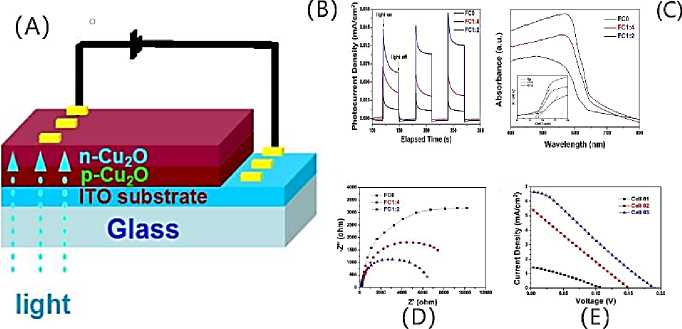
Figure 3. (A) Assembly schematic diagram of P-N Cu 2 O homogeneous junction solar cell (B) Photocurrent density of the sample doped with F Cu 2 O under visible light irradiation and optical switching cycle(C) UV-Vis diffuse reflectance spectra of Fe-doped Cu 2 O samples with different molar ratios of Fe/Cu (D) Electrochemical Impedance Spectrometry of F-doped Cu 2 O electrode measured in Na 2 SO 4 aqueous solution (0.02 M) under dark conditions.(E) I-V curves of three kinds of p-N Cu 2 O homojunction solar cells under AM 1.5 illumination [36]
As early as 2014, Li [49] prepared cuprous oxide/red iron nanotubes (Cu 2 O/ Fe 2 O 3 NTs) by using the constant potential electrodeposition method. Among them, materials with a double-layer copper oxide sphere (Cu 2 O/Fe 2 O 3 NTs-30) show excellent PEC performance, with a suitable band gap (1.96eV) and a minimum superpotential (180mV). In addition, Cu 2 O/Fe 2 O 3 NTs-30 shows two synergies in CO 2 reduction by PEC: (i) between electrocatalysis and photocatalysis, and (ii) between cuproxide and Fe 2 O 3 NTs. After 6 hours, the efficiency and methanol yield of the Faraday method reached 93% and 4.94 mmol L-1cm2, respectively.
In 2018, in order to achieve 24-hour photocatalysis, Lu [50] successfully designed and built a Cu 2 O nanocryststal/TiO 2 microsphere (Cu 2 O NCs/M-TiO 2 ) rotating disk reactor assisted by long afterglow phosphobodies, with the mechanism diagram shown in Figure 4. Experiments show that the composite expands the light response region and improves the quantum efficiency.
It improves the light utilization yield of the photocatalytic system by keeping the catalyst hovering and avoiding the solution shading effect. Finally, 24h photocatalysis was achieved with the help of long afterglow phosphoomes.
In addition, in 2018, Li [51] synthesized the Cu 2 O/TiO 2 complex by rapid chemical reduction. Use as a thin-film electrode raw material for carbon dioxide photoreduction. The composite was then tested as a thin film electrode in the photoreduction of CO 2 in the cathode chamber in different fresh solutions (250mL) at different pH values of 2.0,7.0, and 12.0. CO 2 photoreduction and visible photoactivation of Cu 2 O/TiO 2 composite showed excellent performance at pH of 12. The methanol yield was 1.635 mg/L after 4 h of CO 2 reduction, and CO 2 passed through formaldehyde intermediates. The surface properties of the Cu 2 O/TiO 2 composite have good effects on the band coupling to obtain efficient photocatalytic properties.
Also in 2018, Kulandaivalu [52] synthesized blue, fluorescent carbon quantum dots (CQDs) through a simple top-down hydrothermal method, using biochar as the carbon source. The synthetic CQD is combined with the commercial copper (I) oxide (ferrous copper oxide) nanoparticles to form the CQD/Cu2O nanocomposites. The CQD, Cu2O, and CQD/Cu2O nanocomposites were then applied for gas-phase photocatalytic CO2 reduction. The experimental results showed that the photocatalytic activity of the CQDs/Cu2O nanocomposite photocatalysts was increased by 54% when compared to the original Cu2O.
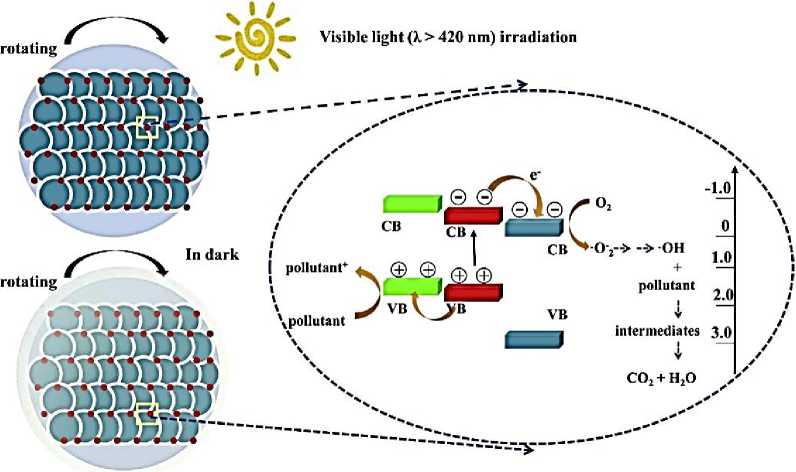
0 M-TiOj Rotating disk • CuzONCs
• CuO Fluorescence from long-afterglow phosphor
Figure 4. Degradation mechanism of pollutants in Cu 2 O NCS /M-TiO 2 rotating disc reactor assisted by long-afterglow phosphor [50]
Oxidation Reaction of the H 2 O
Some advanced oxidation processes (AOP) are characterized by a special chemical feature: the ability to use the high reactivity of the OH free radicals in driving the oxidation processes. These free radicals are suitable for achieving complete emission reduction, including even mineralized [53-55] with less reactive contaminants. In 2005, Carrier [56] used a photocatalytic process to degrade imazapal, a herbicide of the imimazolinone family. It has been shown to rapidly and extensively photodegrade in aqueous solutions. The effect of dissolved metal ions on the photocatalytic degradation rate of titanium dioxide powder is investigated. The results can be summarized as follows: For low concentrations of Cu2+ and Ni2+, the rate constant decreases. At higher concentrations, the plateau was reached. Phototon reactions at higher concentrations reduced negative effects such as photodeposition of CuO and Cu 2 O and recombination of h+/e-. In 2020, Omrani [3] demonstrated that for individual Cu 2 O or CdS semiconductors, the coupling of Cu 2 O and CdS nanoparticles (NPs) showed enhanced photocatalytic activity in the degradation of sulfamalazine (SSZ) in aqueous solution. Experiments show that the improved photocatalytic activity of the Cu 2 O-CdS composite is associated with a better charge transfer between the charge carriers in the composite.
As early as 2013, Wang [57] deposited Cu2O/TiO2p-n heterojunction photoelectrodes on n-type titanium dioxide nanotubes (Figure 5A.C.D). Loading of copper oxide nanoparticles enhanced the visible light response of titanium dioxide NTAs. The photocatalysts with a small amount of copper oxide nanoparticles loaded on Ti 2 nanotubes showed the maximum photo flow and photoconversion efficiency under both UV and visible light irradiation, as well as the highest visible photocatalytic degradation rate of RhB, and the degradation mechanism diagram is shown in Figure 5B. In particular, when the 0.5V bias potential is applied, the Cu2O/TiO2NTA photoelectrode has a superior photocatalytic efficiency due to the synergistic effect of electrical and visible light irradiation, and thus it is one of the candidates for environmental applications of wastewater treatment and water light-induced splitting into hydrogen.
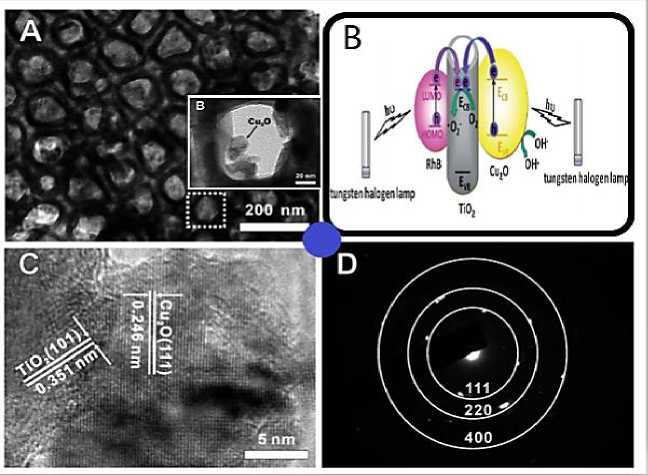
Figure 5. (A) Low magnification TEM image of Cu 2 O/TiO 2 NTAS prepared by ultrasound-assisted S-CBD for 4 min (top view). (B) Schematic diagram of photocatalytic degradation of RHB by Cu 2 O/TiO 2 NTAS under visible light (C) High-resolution TEM images of Cu 2 O/TiO 2 NTAS.(D) Cu 2 O is selected from the Region Electron Diffraction (SAED) mode of (C) nanoparticles [57]
Later, by 2020, Wang [58] prepared the Cu 2 O-Pt/SiC/IrOx composite by controlled photodeposition and used the Nafion membrane as an artificial photosynthetic system to separate reduction and oxidation. To find out the optimal co-catalyst content, they tested the photocatalytic activity of the sample on the reaction of CO 2 with H 2 O under visible light irradiation and found that HCOOH was the main product of all the photocatalysts. When IrOx and Cu 2 O were deposited simultaneously on the optimal Pt/SiC, the HCOOH yield was highest at an IrOx content of ~ 2.2 wt% and a Cu 2 O content of ~ 1.8 wt%, respectively. The deposition of a too-thick Cu 2 O layer rather than that on the surface of the Pt was unfavorable at a Cu 2 O content higher than 1.8 wt%. The HCOOH yield was almost 37 times more abundant than the naked SiC activity under the optimal Cu 2 O-Pt/SiC/IrOx conditions. This artificial system showed excellent photocatalytic performance in CO 2 reduction to HCOOH and the oxidation of H 2 O to O 2 under visible light irradiation. The yields of HCOOH and O 2 essentially coincided with the stoichiometry, being as high as 896.7 and 440.7 μmol g-1 h-1, respectively. The high efficiency of CO 2 reduction and H 2 O oxidation in the artificial system is attributed to the direct z-format electronic structure of the Cu 2 O-Pt/SiC/IrOx and the spatially separated indirect z-format reduction and oxidation units. This greatly extends the service life of photogenerated electrons and holes and prevents the reverse reaction of the products. This study provides an effective and feasible strategy to improve artificial photosynthetic efficiency.
Light Degradation
In recent years, metal oxide semiconductors have received increasing attention as a catalyst for photocatalytic degradation of organic pollutants in water, which is conducive to solving environmental problems related to wastewater [59-62].
Photochemical Degradation
Photochemical degradation refers to the reaction of organic compounds into homologues with less carbon atoms under the action of light. In 2012, An [63] used a combination of catalysts (FeCu and Cu2O) to degrade five commonly used drugs and personal care products (PPCPs). The current between Cu and Fe increases the dissolution rate of the anode iron as compared to the internal microcircuit of Fe/Moreover, due to the photochemical properties, Cu2O can accelerate the degradation process of PPCPs under visible light irradiation.
Also in 2012, Zhu [64] successfully prepared the Cu 2 O/AS composites by using a simple deposition method (Figure 6C). Acid-treated silica (AS) fibers are excellent carriers for Cu 2 O particles (Figure 6A). AS improves the optical properties of Cu 2 O and redshifts the band gap, thus improving the use of visible light, and thus effectively improving the photocatalytic activity of Cu 2 O.The Cu 2 O/AS composites showed excellent photo- catalytic properties in the degradation of red water (Figure 6B).The 87.0% red water can be photocatalyzed degraded by Cu 2 O/AS 5h after irradiation, and most of the organic com- ponents of red water were degraded except 1,3,5-trinitrobenzene.
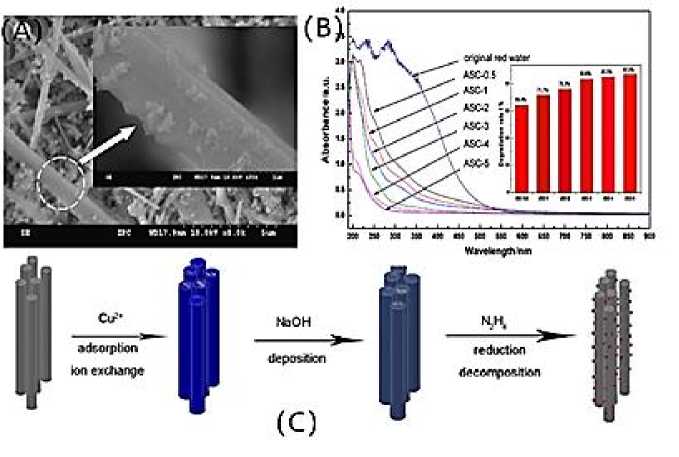
Figure 6. (A) SEM images of different Cu 2 O/ As samples. (B) UV-Vis spectra of residual red water treated with different photocatalysts for 5 h.(C) Cu 2 O/ As preparation process schematic diagram [64]
Cu 2 O is a low-cost semiconductor with narrow band gap, high absorption coefficient and suitable conduction band, but it has low charge mobility, poor quantum yield and poor catalytic performance. However, in 2017, Zhang [65] greatly improved the catalytic capacity of Cu 2 O for the degradation of fire-resistant pollutants with a simple and effective strategy. Using a synergistic effect of photocatalysis and Fenton, Scheme I propose a novel and highly efficient photocatalytic-driven Fenton system for the PFC. The Cu 2 O/nano C mix was used and experimentally verified. The synergistic PFC is highly dependent on nanoscale C and facilitates the wastewater removal of rhodamine B and p-nitrophenol, two typical fire-resistant contaminants.
+ не’
PFC on Cu2O/C: O2 —L> -
+ 2r+2ir _ _ „
—-----> H2 O2 a (m ain)
+ C cocatalyst
--——>■ OH + OH- (main) + Fc2*cocatatyst
■O2(mino

^2 fr„
2OH-(minor)
The synergistic O 2 continuous reduction pathway of PFC by Cu 2 O and Cu 2 O/Nano-C complexes under visible light irradiation (λ > 420 nm) [65].
Бюллетень науки и практики / Bulletin of Science and Practice Т. 9. №3. 2023
Antibiotics and heavy metals often coexist in the polluted environment, and the harm of compound pollution is greater than that of a single pollution. In 2019, Huang [66] synthesized a series of graphene-loaded p-n heterojunction rGO@Cu 2 O/BiVO 4 composi- tes, doped with different Cu 2 O, for the simultaneous detoxification of Cr (VI) and antibiotics. In this study, a series of p-n heterojunction composite materials, rGO@Cu 2 O/BiVO 4 , was applied to the efficient reduction and SMZ oxidation of Cr (VI) under LED light. With the increase of the Cu 2 O load, the photoabsorption performance of LED improves, and the appropriate band gap of the p-n heterojunction enables its effective electron/hole separation, ensuring the photocatalytic activity of LED. This work provides a new method for the coexistence of Cr (VI) and antibiotic pollutants in wastewater treated by rGO@Cu 2 O/BiVO 4 p-n heterojunction compound synthesis.
Polymer Photodegradation
Polymer photodegradation is one of the research advances in the field of light energy. With the deepening of the research in the field of light energy, polymer photodegradation has increasingly attracted the attention of researchers. In the process of applying this method, many problems have become highlighted, and the discussion on polymer photodegradation is becoming increasingly fierce.
Back in 2015, Falah [67] introduced the synthesis of spherical Cu 2 O nanoparticles and a composite of P25 TiO 2 with aluminsilicate inorganic polymer (ground polymer), and XRD and FTIR confirmed that the addition of Cu 2 O/TiO 2 nanoparticles had no effect on the formation of the polymer matrix. But experiments under dark conditions and under UV irradiation show that the composite removes the MB dye through a combination of adsorption and photodegradation without disrupting the structure of the polymer. The combination of nanometer Cu 2 O particles and photoreactive P25 titanium in an aluminosilicate inorganic polymer substrate under UV irradiation is a more effective photocatalyst than a single oxide under UV irradiation. It can effectively remove the model organic contaminant methylene blue dye in solution.
Later, in 2016, Zhang [68] synthesized a new copy oxide nanocomposite (Cu 2 O@3D-rGO@NCS) by one-step in situ reduction (Figure 7a). The Cu 2 O@3D-rGO@NCS has an excellent photocatalytic capability, thanks to the high porosity of the 3D-rGO, the efficient charge transfer from the Cu 2 O to the rGO, and the high adsorption capacity of the NCS (Figure 7d). XPS, SEM, and TEM show that Cu 2 O nanospheres and NCS particles are evenly distributed on 3D-rGO sheets. The porous and mesh structure of 3D-rGO not only improves the high load of Cu 2 O and improves the adsorption capacity of dye molecules, but also promotes the rapid transfer of optoelectronics (Figure 7b). The Cu 2 O@3D rGO was @ N C S improved RhB PGs efficiency compared to the Cu 2 O nanosphere and Cu 2 O@3D-rGO nanocomposites and the nanocomposites, respectively (Figure 7c.e.f). Interestingly, the simple method proposed in this study may be extended to the synthesis of other nanocomposites with various functions grown on 3D-rGO sheets.
In addition, in 2018, Anku [69] proposed the biolorization of acrylic acid (Gg) grafted acrylic acid (AA) and acrylamide (AAm) (Cu 2 O/Gg AAm AA) as nano Cu 2 O particles. The results show that Cu 2 O/Gg AAm AA is a good photocatalyst to effectively remove naphthol blue-black dye from water. The procedure has an optimal pH value of 6. The photodecolorization process enhanced with increasing catalyst concentration but showed a decreasing trend above 0.3 g L-1. The excellent photodegradation efficiency of the nanocomposite is attributed to the excellent dye molecule adsorption capacity of the Gg AAm AA polymer matrix, as well as the high visible photoactivity and photocatalytic properties of the Cu 2 O nanoparticles. The recyclability studies show that Cu 2 O/Gg AAm AA nanocomposites can be efficiently recycled and reused.
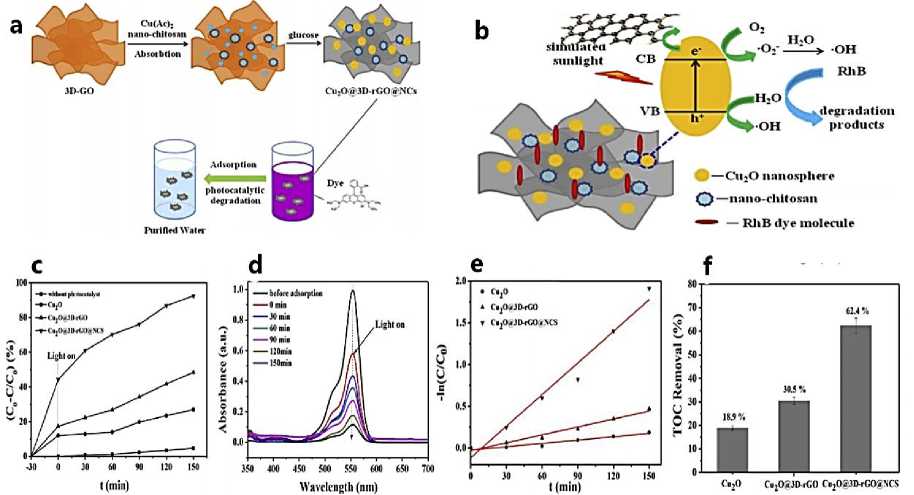
Figure 7. (a) A schematic diagram of photocatalytic degradation of RhB using the developed Cu 2 O@3D-rGO@NCS nanocomposite as a photocatalyst.(b) Using Cu 2 O @3D-rGO@NCS nanocomposite as photocatalyst, the schematic diagram of charge separation and photodegradation mechanism of RhB dye of @NCS nanocomposite under solar irradiation was simulated.(c) The presence of Cu 2 O nanospheres, Cu 2 O @3D-rGO, and Acr@NCs in simulated sunlight, and the elimination of RhB in the absence of photocatalyst.(d) UV-Vis absorption spectra of RhB in the presence of Cu 2 O @3D-rGO@NCS nanocomposites.(E) The change curve of eln(C/C 0 ) in photodegradation of RhB aqueous solution with simulated illumination time in the presence of Cu 2 O, Cu 2 O @3D-rGO and FeN@NCS.(f) The percentage of TOC in RhB aqueous solution was removed by Cu 2 O, Cu 2 O @3D-rGO and NaNi@NCS [68]
In 2019, Razmara [70] synthesized the [Cu 2 (μ‐ox)2(pyz)3]n (Pyz = pyrazine + ox = oxalate) supramolecular coordination complex under ultrasound irradiation. Studies of the complex show that the complex has good thermal stability and is a weak ferromagnet. After characterization with various techniques, octahedral Cu 2 O nanoparticles with edge lengths of 5-80 nm were produced by calcination at 600°C.The adsorption capacity and photocatalytic activity of octahedral Cu 2 O nanoparticles at room temperature were investigated. The final results indicate that octahedral Cu 2 O nanoparticles play an important role in the degradation and adsorption of RB, with a maximum degradation efficiency of 91.7% and a maximum adsorption capacity of 83.3mg/g at 40min.
Also in 2019, Xu [71] prepared Cu 2 O/ PLA composite nanofibers through surface modification induced by electron beam irradiation by using PLA fibers as a carrier for Cu 2 O nanoparticles. Based on the FTIR spectroscopy, the binding of the Cu 2 O nanoparticles and the PLA particles can be attributed to the strong hydrogen bonds between them, so that the Cu 2 O nanoparticles can be uniformly dispersed on the PLA fragments to form a composite membrane. The obtained Cu 2 O/PLA nanofibers showed excellent photocatalytic properties in the organic pollutants of soil and water systems (e. g., MO and bran ether). Antimicrobial tests show that the prepared composites can enhance the antimicrobial properties. This provides an idea to constructing bifunctional composites for effective degradation of organic pollutants in soil and water systems.
Conclusions and Outlook
It has abundant raw materials, high theoretical conversion efficiency, high efficiency photoelectric catalytic performance, proper band gap of p-n heterojunction, strong oxidation capacity and good stability; both as nanomaterials to improve the performance of solar cells, and as composite materials to help decompose environmental pollutants. With the deepening of relevant research, more
Бюллетень науки и практики / Bulletin of Science and Practice Т. 9. №3. 2023 and more excellent properties of nano copper oxide will be explored and developed. It is believed that in the near future, these products will be widely used in real life, and they will play a decisive role in solving the problem of human living resources and living environment.
Список литературы Research progress of p-type cuprous oxide in the field of light energy utilization
- Yu, W., Li, F., Wang, H., Alarousu, E., Chen, Y., Lin, B., ... & Wu, T. (2016). Ultrathin Cu2O as an efficient inorganic hole transporting material for perovskite solar cells. Nanoscale, 8(11), 6173–6179. https://doi.org/10.1039/C5NR07758C
- Gusain, R., Kumar, P., Sharma, O. P., Jain, S. L., & Khatri, O. P. (2016). Reduced graphene oxide–CuO nanocomposites for photocatalytic conversion of CO2 into methanol under visible light irradiation. Applied Catalysis B: Environmental, 181, 352–362. https://doi.org/10.1016/j.apcatb.2015.08.012
- Omrani, N., & Nezamzadeh-Ejhieh, A. (2020). Focus on scavengers’ effects and GC-MASS analysis of photodegradation intermediates of sulfasalazine by Cu2O/CdS nanocomposite. Separation and Purification Technology, 235, 116228. https://doi.org/10.1016/j.seppur.2019.116228
- Izaki, M., Shinagawa, T., Mizuno, K. T., Ida, Y., Inaba, M., & Tasaka, A. (2007). Electrochemically constructed p-Cu2O/n-ZnO heterojunction diode for photovoltaic device. Journal of Physics D: Applied Physics, 40(11), 3326.
- Ali, S., Lee, J., Kim, H., Hwang, Y., Razzaq, A., Jung, J. W., ... & In, S. I. (2020). Sustained, photocatalytic CO2 reduction to CH4 in a continuous flow reactor by earth-abundant materials: Reduced titania-Cu2O Z-scheme heterostructures. Applied Catalysis B: Environmental, 279, 119344. https://doi.org/10.1016/j.apcatb.2020.119344
- Chen, J., Liu, X., Zhang, H., Liu, P., Li, G., An, T., & Zhao, H. (2016). Soft-template assisted synthesis of mesoporous CuO/Cu2O composite hollow microspheres as efficient visible-light photocatalyst. Materials Letters, 182, 47-51. https://doi.org/10.1016/j.matlet.2016.06.077
- Chen, S., Lin, L., Liu, J., Lv, P., Wu, X., Zheng, W., ... & Lai, F. (2015). An electrochemical constructed p-Cu2O/n-ZnO heterojunction for solar cell. Journal of Alloys and Compounds, 644, 378-382. https://doi.org/10.1016/j.jallcom.2015.02.230
- Zuo, C., & Ding, L. (2015). Solution‐processed Cu2O and CuO as hole transport materials for efficient perovskite solar cells. Small, 11(41), 5528–5532. https://doi.org/10.1002/smll.201501330
- Zhang, L., Sun, H., Xie, L., Lu, J., Zhang, L., Wu, S., ... & Liu, J. M. (2015). Inorganic solar cells based on electrospun ZnO nanofibrous networks and electrodeposited Cu2O. Nanoscale research letters, 10(1), 1–13. https://doi.org/10.1186/s11671-015-1169-8
- Koo, H. S., Wang, D. T., Yu, Y. K., Ho, S. H., Jhang, J. Y., Chen, M., & Tai, M. F. (2012). Effect of Cu2O Doping in TiO2 Films on Device Performance of Dye-Sensitized Solar Cells. Japanese Journal of Applied Physics, 51(10S), 10NE18.
- Miao, X., Wang, S., Sun, W., Zhu, Y., Du, C., Ma, R., & Wang, C. (2019). Effect of Cu2O Content in Electrodeposited CuOx Film on Perovskite Solar Cells. Nano, 14(10), 1950126. https://doi.org/10.1142/S1793292019501261
- Polat, Ö., Aytug, T., Lupini, A. R., Paranthaman, P. M., Ertugrul, M., Bogorin, D. F., ... & Christen, D. K. (2013). Nanostructured columnar heterostructures of TiO2 and Cu2O enabled by a thin-film self-assembly approach: Potential for photovoltaics. Materials Research Bulletin, 48(2), 352–356. https://doi.org/10.1016/j.materresbull.2012.10.044
- Shang, Y., & Guo, L. (2015). Facet‐Controlled Synthetic Strategy of Cu2O‐Based Crystals for Catalysis and Sensing. Advanced Science, 2(10), 1500140. https://doi.org/10.1002/advs.201500140
- Zeng, Z., Yan, Y., Chen, J., Zan, P., Tian, Q., & Chen, P. (2019). Boosting the photocatalytic ability of Cu2O nanowires for CO2 conversion by MXene quantum dots. Advanced Functional Materials, 29(2), 1806500. https://doi.org/10.1002/adfm.201806500
- Robatjazi, H., Zhao, H., Swearer, D. F., Hogan, N. J., Zhou, L., Alabastri, A., ... & Halas, N. J. (2017). Plasmon-induced selective carbon dioxide conversion on earth-abundant aluminum-cuprous oxide antenna-reactor nanoparticles. Nature communications, 8(1), 1-10. https://doi.org/10.1038/s41467-017-00055-z
- Wu, Y. A., McNulty, I., Liu, C., Lau, K. C., Liu, Q., Paulikas, A. P., ... & Rajh, T. (2019). Facet-dependent active sites of a single Cu2O particle photocatalyst for CO2 reduction to methanol. Nature Energy, 4(11), 957–968. https://doi.org/10.1038/s41560-019-0490-3
- Blackburn, B., Hassan, I., Zhang, C., Blackman, C., Holt, K., & Carmalt, C. (2016). Aerosol assisted chemical vapour deposition synthesis of copper (I) oxide thin films for CO2 reduction photocatalysis. Journal of Nanoscience and Nanotechnology, 16(9), 10112–10116. https://doi.org/10.1166/jnn.2016.12843
- Miller, E. B., Zahran, E. M., Knecht, M. R., & Bachas, L. G. (2017). Metal oxide semiconductor nanomaterial for reductive debromination: Visible light degradation of polybrominated diphenyl ethers by Cu2O@ Pd nanostructures. Applied Catalysis B: Environmental, 213, 147–154. https://doi.org/10.1016/j.apcatb.2017.05.020
- Kumar, A., Kumar, A., Sharma, G., Ala'a, H., Naushad, M., Ghfar, A. A., & Stadler, F. J. (2018). Quaternary magnetic BiOCl/g-C3N4/Cu2O/Fe3O4 nano-junction for visible light and solar powered degradation of sulfamethoxazole from aqueous environment. Chemical Engineering Journal, 334, 462–478. https://doi.org/10.1016/j.cej.2017.10.049
- Cui, W., An, W., Liu, L., Hu, J., & Liang, Y. (2014). Novel Cu2O quantum dots coupled flower-like BiOBr for enhanced photocatalytic degradation of organic contaminant. Journal of hazardous materials, 280, 417–427. https://doi.org/10.1016/j.jhazmat.2014.08.032
- Yu, X., Zhang, J., Zhang, J., Niu, J., Zhao, J., Wei, Y., & Yao, B. (2019). Photocatalytic degradation of ciprofloxacin using Zn-doped Cu2O particles: analysis of degradation pathways and intermediates. Chemical Engineering Journal, 374, 316–327. https://doi.org/10.1016/j.cej.2019.05.177
- Cui, Y., Wang, C., Liu, G., Yang, H., Wu, S., & Wang, T. (2011). Fabrication and photocatalytic property of ZnO nanorod arrays on Cu2O thin film. Materials Letters, 65(14), 2284–2286. https://doi.org/10.1016/j.matlet.2011.04.041
- Chen, R., Lu, J., Wang, Z., Zhou, Q., & Zheng, M. (2018). Microwave synthesis of Cu/Cu2O/SnO2 composite with improved photocatalytic ability using SnCl4 as a protector. Journal of Materials Science, 53(13), 9557–9566. https://doi.org/10.1007/s10853-018-2261-0
- Grondahl, L. O. (1933). The copper-cuprous-oxide rectifier and photoelectric cell. Reviews of Modern Physics, 5(2), 141. https://doi.org/10.1103/RevModPhys.5.141
- Omelchenko, S. T., Tolstova, Y., Atwater, H. A., & Lewis, N. S. (2017). Excitonic effects in emerging photovoltaic materials: A case study in Cu2O. ACS Energy Letters, 2(2), 431–437.
- Hu, P., Du, W., Wang, M., Wei, H., Ouyang, J., Qian, Z., & Tian, Y. (2020). Reduced bandgap and enhanced p-type electrical conduction in Ag-alloyed Cu2O thin films. Journal of Applied Physics, 128(12), 125302. https://doi.org/10.1063/5.0019408
- Izaki, M., Fukazawa, K., Sato, K., Khoo, P. L., Kobayashi, M., Takeuchi, A., & Uesugi, K. (2019). Defect structure and photovoltaic characteristics of internally stacked CuO/Cu2O photoactive layer prepared by electrodeposition and heating. ACS Applied Energy Materials, 2(7), 4833–4840. https://doi.org/10.1021/acsaem.9b00514
- Zang, Z. (2018). Efficiency enhancement of ZnO/Cu2O solar cells with well oriented and micrometer grain sized Cu2O films. Applied Physics Letters, 112(4), 042106. https://doi.org/10.1063/1.5017002
- Hossain, M. I., Alharbi, F. H., & Tabet, N. (2015). Copper oxide as inorganic hole transport material for lead halide perovskite based solar cells. Solar Energy, 120, 370-380. https://doi.org/10.1016/j.solener.2015.07.040
- Nejand, B. A., Ahmadi, V., Gharibzadeh, S., & Shahverdi, H. R. (2016). Cuprous oxide as a potential low‐cost hole‐transport material for stable perovskite solar cells. ChemSusChem, 9(3), 302–313. https://doi.org/10.1002/cssc.201501273
- Guo, Y., Lei, H., Xiong, L., Li, B., Chen, Z., Wen, J., ... & Fang, G. (2017). Single phase, high hole mobility Cu 2 O films as an efficient and robust hole transporting layer for organic solar cells. Journal of Materials Chemistry A, 5(22), 11055–11062. https://doi.org/10.1039/C7TA01628J
- Elseman, A. M., Selim, M. S., Luo, L., Xu, C. Y., Wang, G., Jiang, Y., ... & Song, Q. L. (2019). Efficient and Stable Planar np Perovskite Solar Cells with Negligible Hysteresis through Solution Processed Cu2O Nanocubes as a Low‐Cost Hole‐Transport Material. ChemSusChem, 12(16), 3808–3816. https://doi.org/10.1002/cssc.201901430
- Jeong, S. S., Mittiga, A., Salza, E., Masci, A., & Passerini, S. (2008). Electrodeposited ZnO/Cu2O heterojunction solar cells. Electrochimica Acta, 53(5), 2226–2231. https://doi.org/10.1016/j.electacta.2007.09.030
- Soundaram, N., Chandramohan, R., Valanarasu, S., Thomas, R., & Kathalingam, A. (2015). Studies on SILAR deposited Cu2O and ZnO films for s https://doi.org/10.1007/s10854-015-3020-5olar cell applications. Journal of Materials Science: Materials in Electronics, 26(7), 5030–5036. https://doi.org/10.1007/s10854-015-3020-5
- Gershon, T., Musselman, K. P., Marin, A., Friend, R. H., & MacManus-Driscoll, J. L. (2012). Thin-film ZnO/Cu2O solar cells incorporating an organic buffer layer. Solar Energy Materials and Solar Cells, 96, 148–154. https://doi.org/10.1016/j.solmat.2011.09.043
- Yu, L., Xiong, L., & Yu, Y. (2015). Cu2O homojunction solar cells: F-doped N-type thin film and highly improved efficiency. The Journal of Physical Chemistry C, 119(40), 22803–22811. https://doi.org/10.1021/acs.jpcc.5b06736
- Naz, G., Shamsuddin, M., Butt, F. K., Bajwa, S. Z., Khan, W. S., Irfan, M., & Irfan, M. (2019). Au/Cu2O core/shell nanostructures with efficient photoresponses. Chinese Journal of Physics, 59, 307–316. https://doi.org/10.1016/j.cjph.2019.03.008
- Chang, X., Wang, T., Zhang, P., Wei, Y., Zhao, J., & Gong, J. (2016). Stable aqueous photoelectrochemical CO2 reduction by a Cu2O dark cathode with improved selectivity for carbonaceous products. Angewandte Chemie International Edition, 55(31), 8840–8845. https://doi.org/10.1002/anie.201602973
- Yuan, Q., Chen, L., Xiong, M., He, J., Luo, S. L., Au, C. T., & Yin, S. F. (2014). Cu2O/BiVO4 heterostructures: synthesis and application in simultaneous photocatalytic oxidation of organic dyes and reduction of Cr (VI) under visible light. Chemical Engineering Journal, 255, 394–402. https://doi.org/10.1016/j.cej.2014.06.031
- Omrani, N., & Nezamzadeh-Ejhieh, A. (2020). A comprehensive study on the enhanced photocatalytic activity of Cu2O/BiVO4/WO3 nanoparticles. Journal of Photochemistry and Photobiology A: Chemistry, 389, 112223. https://doi.org/10.1016/j.jphotochem.2019.112223
- Liu, A., Zhu, Y., Li, K., Chu, D., Huang, J., Li, X., ... & Du, Y. (2018). A high performance p-type nickel oxide/cuprous oxide nanocomposite with heterojunction as the photocathodic catalyst for water splitting to produce hydrogen. Chemical Physics Letters, 703, 56–62. https://doi.org/10.1016/j.cplett.2018.05.020
- Li, H., Lei, Y., Huang, Y., Fang, Y., Xu, Y., Zhu, L., & Li, X. (2011). Photocatalytic reduction of carbon dioxide to methanol by Cu2O/SiC nanocrystallite under visible light irradiation. Journal of Natural Gas Chemistry, 20(2), 145–150. https://doi.org/10.1016/S1003-9953(10)60166-1
- Li, Y., Wang, W. N., Zhan, Z., Woo, M. H., Wu, C. Y., & Biswas, P. (2010). Photocatalytic reduction of CO2 with H2O on mesoporous silica supported Cu/TiO2 catalysts. Applied Catalysis B: Environmental, 100(1-2), 386-392. https://doi.org/10.1016/j.apcatb.2010.08.015
- Guo, L., Cao, J., Zhang, J., Hao, Y., & Bi, K. (2019). Photoelectrochemical CO2 reduction by Cu2O/Cu2S hybrid catalyst immobilized in TiO2 nanocavity arrays. Journal of Materials Science, 54(14), 10379-10388. https://doi.org/10.1007/s10853-019-03615-4
- Zhou, C., Wang, S., Zhao, Z., Shi, Z., Yan, S., & Zou, Z. (2018). A Facet‐Dependent Schottky‐Junction Electron Shuttle in a BiVO4 {010}–Au–Cu2O Z‐Scheme Photocatalyst for Efficient Charge Separation. Advanced Functional Materials, 28(31), 1801214. https://doi.org/10.1002/adfm.201801214
- Zhang, W., Shi, L., Tang, K., & Dou, S. (2010). Controllable synthesis of Cu2O microcrystals via a complexant‐assisted synthetic route. https://doi.org/10.1002/ejic.200900866
- Chang, P. Y., & Tseng, I. H. (2018). Photocatalytic conversion of gas phase carbon dioxide by graphitic carbon nitride decorated with cuprous oxide with various morphologies. Journal of CO2 Utilization, 26, 511–521. https://doi.org/10.1016/j.jcou.2018.06.009
- Ojha, N., Bajpai, A., & Kumar, S. (2021). Enriched oxygen vacancies of Cu2O/SnS2/SnO2 heterostructure for enhanced photocatalytic reduction of CO2 by water and nitrogen fixation. Journal of Colloid and Interface Science, 585, 764–777. https://doi.org/10.1016/j.jcis.2020.10.056
- Li, P., Jing, H., Xu, J., Wu, C., Peng, H., Lu, J., & Lu, F. (2014). High-efficiency synergistic conversion of CO 2 to methanol using Fe 2 O 3 nanotubes modified with double-layer Cu 2 O spheres. Nanoscale, 6(19), 11380–11386. https://doi.org/10.1039/C4NR02902J
- Lu, Y., Zhang, X., Chu, Y., Yu, H., Huo, M., Qu, J., ... & Yuan, X. (2018). Cu2O nanocrystals/TiO2 microspheres film on a rotating disk containing long-afterglow phosphor for enhanced round-the-clock photocatalysis. Applied Catalysis B: Environmental, 224, 239–248. https://doi.org/10.1016/j.apcatb.2017.10.054
- Li, B., Niu, W., Cheng, Y., Gu, J., Ning, P., & Guan, Q. (2018). Preparation of Cu2O modified TiO2 nanopowder and its application to the visible light photoelectrocatalytic reduction of CO2 to CH3OH. Chemical Physics Letters, 700, 57–63. https://doi.org/10.1016/j.cplett.2018.03.049
- Kulandaivalu, T., Rashid, S. A., Sabli, N., & Tan, T. L. (2019). Visible light assisted photocatalytic reduction of CO2 to ethane using CQDs/Cu2O nanocomposite photocatalyst. Diamond and Related Materials, 91, 64–73. https://doi.org/10.1016/j.diamond.2018.11.002
- Masegi, H., Goto, H., Sadale, S. B., & Noda, K. (2020). Real-time monitoring of photocatalytic methanol decomposition over Cu2O-loaded TiO2 nanotube arrays in high vacuum. Journal of Vacuum Science & Technology B, Nanotechnology and Microelectronics: Materials, Processing, Measurement, and Phenomena, 38(5), 052401. https://doi.org/10.1116/6.0000194
- Fujita, S. I., Kawamori, H., Honda, D., Yoshida, H., & Arai, M. (2016). Photocatalytic hydrogen production from aqueous glycerol solution using NiO/TiO2 catalysts: Effects of preparation and reaction conditions. Applied Catalysis B: Environmental, 181, 818–824. https://doi.org/10.1016/j.apcatb.2015.08.048
- Tawfik, W. Z., Hassan, M. A., Johar, M. A., Ryu, S. W., & Lee, J. K. (2019). Highly conversion efficiency of solar water splitting over p-Cu2O/ZnO photocatalyst grown on a metallic substrate. Journal of Catalysis, 374, 276–283. https://doi.org/10.1016/j.jcat.2019.04.045
- Carrier, M., Perol, N., Herrmann, J. M., Bordes, C., Horikoshi, S., Paisse, J. O., ... & Guillard, C. (2006). Kinetics and reactional pathway of Imazapyr photocatalytic degradation Influence of pH and metallic ions. Applied Catalysis B: Environmental, 65(1–2), 11–20. https://doi.org/10.1016/j.apcatb.2005.11.014
- Wang, M., Sun, L., Lin, Z., Cai, J., Xie, K., & Lin, C. (2013). p–n Heterojunction photoelectrodes composed of Cu 2 O-loaded TiO 2 nanotube arrays with enhanced photoelectrochemical and photoelectrocatalytic activities. Energy & Environmental Science, 6(4), 1211–1220. https://doi.org/10.1039/C3EE24162A
- Wang, Y., Shang, X., Shen, J., Zhang, Z., Wang, D., Lin, J., ... & Li, C. (2020). Direct and indirect Z-scheme heterostructure-coupled photosystem enabling cooperation of CO2 reduction and H2O oxidation. Nature communications, 11(1), 1–11. https://doi.org/10.1038/s41467-020-16742-3
- Deng, X., Zhang, Q., Zhou, E., Ji, C., Huang, J., Shao, M., ... & Xu, X. (2015). Morphology transformation of Cu2O sub-microstructures by Sn doping for enhanced photocatalytic properties. Journal of Alloys and Compounds, 649, 1124–1129. https://doi.org/10.1016/j.jallcom.2015.07.124
- Ping, T., Mihua, S., Chengwen, S., Shuaihua, W., & Murong, C. (2016). Enhanced photocatalytic activity of Cu2O/Cu heterogeneous nanoparticles synthesized in aqueous colloidal solutions on degradation of methyl orange. Rare Metal Materials and Engineering, 45(9), 2214–2218. https://doi.org/10.1016/S1875-5372(17)30005-X
- Shi, Y., Yang, Z., Wang, B., An, H., Chen, Z., & Cui, H. (2016). Adsorption and photocatalytic degradation of tetracycline hydrochloride using a palygorskite-supported Cu2O–TiO2 composite. Applied Clay Science, 119, 311–320. https://doi.org/10.1016/j.clay.2015.10.033
- Tang, Q., Wu, W., Zhang, B., Luo, J., Zhang, H., Guo, X., ... & Cao, J. (2019). A novel in situ synthesis of Cu/Cu2O/CuO/sulfonated polystyrene heterojunction photocatalyst with enhanced photodegradation activity. Journal of Inorganic and Organometallic Polymers and Materials, 29(2), 340–345. https://doi.org/10.1007/s10904-018-1004-7
- An, J., & Zhou, Q. (2012). Degradation of some typical pharmaceuticals and personal care products with copper-plating iron doped Cu2O under visible light irradiation. Journal of Environmental Sciences, 24(5), 827–833. https://doi.org/10.1016/S1001-0742(11)60847-4
- Zhu, Q., Zhang, Y., Lv, F., Chu, P. K., Ye, Z., & Zhou, F. (2012). Cuprous oxide created on sepiolite: preparation, characterization, and photocatalytic activity in treatment of red water from 2, 4, 6-trinitrotoluene manufacturing. Journal of Hazardous Materials, 217, 11–18. https://doi.org/10.1016/j.jhazmat.2011.12.053
- Zhang, A. Y., He, Y. Y., Lin, T., Huang, N. H., Xu, Q., & Feng, J. W. (2017). A simple strategy to refine Cu2O photocatalytic capacity for refractory pollutants removal: Roles of oxygen reduction and Fe (II) chemistry. Journal of hazardous materials, 330, 9–17. https://doi.org/10.1016/j.jhazmat.2017.01.051
- Huang, Z., Dai, X., Huang, Z., Wang, T., Cui, L., Ye, J., & Wu, P. (2019). Simultaneous and efficient photocatalytic reduction of Cr (VI) and oxidation of trace sulfamethoxazole under LED light by rGO@ Cu2O/BiVO4 pn heterojunction composite. Chemosphere, 221, 824–833. https://doi.org/10.1016/j.chemosphere.2019.01.087
- Falah, M., & MacKenzie, K. J. (2015). Synthesis and properties of novel photoactive composites of P25 titanium dioxide and copper (I) oxide with inorganic polymers. Ceramics International, 41(10), 13702–13708. https://doi.org/10.1016/j.ceramint.2015.07.198
- Zhang, Z., Zhai, S., Wang, M., Ji, H., He, L., Ye, C., ... & Zhang, H. (2016). Photocatalytic degradation of rhodamine B by using a nanocomposite of cuprous oxide, three-dimensional reduced graphene oxide, and nanochitosan prepared via one-pot synthesis. Journal of Alloys and Compounds, 659, 101–111. https://doi.org/10.1016/j.jallcom.2015.11.027
- Anku, W. W., Shukla, S. K., & Govender, P. P. (2018). Graft Gum Ghatti Caped Cu2O nanocomposite for photocatalytic degradation of naphthol blue black dye. Journal of Inorganic and Organometallic Polymers and Materials, 28(4), 1540–1551. https://doi.org/10.1007/s10904-018-0875-y
- Razmara, Z., & Poorsargol, M. (2019). Ultrasonic‐assisted synthesis of supramolecular copper (II) complex a precursor for the preparation of octahedron Cu2O nanoparticles applicable in the adsorption and photodegradation of Rhodamine B. Applied Organometallic Chemistry, 33(9), e5084. https://doi.org/10.1002/aoc.5084
- Xu, Q., Huang, Z., Ji, S., Zhou, J., Shi, R., & Shi, W. (2020). Cu2O nanoparticles grafting onto PLA fibers via electron beam irradiation: bifunctional composite fibers with enhanced photocatalytic of organic pollutants in aqueous and soil systems. Journal of Radioanalytical and Nuclear Chemistry, 323(1), 253–261. https://doi.org/10.1007/s10967-019-06842-w

